How to build a well in the country: tips for a beginner
How to determine the approximate depth of the future well? Where better to place it? What to make walls and how to close the well in the country?
In the article we will try to find answers to these and some other questions.
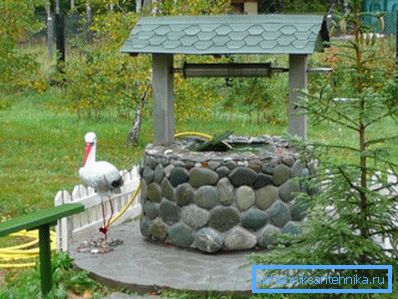
Location
What are the criteria for choosing a place for the future of the well?
- Distance from home. A reasonable minimum is about five meters: in this case, you do not risk a subsidence of the foundation while digging. The maximum distance is limited only by the size of the plot.
However: if the well is supposed to be used not only for irrigation, but also as a source of constant water supply, it will be necessary to lay a lead from it - a plastic or steel pipe. It digs below the ground freezing level. It is clear that more distance from the house means more earthworks.
- Removal from sources of groundwater pollution - landfills, untight cesspools, filter wells of local sewage, and so on. According to the current sanitary norms and rules (SanPiN), the minimum distance from them to poorly protected water intake (and the well falls into this category) is 50 meters.
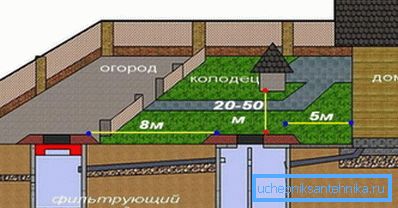
- In areas with difficult terrain, a well digs in one of the lowlands. The instruction is connected with the fact that there the distance to the aquifer is minimal.
Depth
As a rule, the depth of the well, which is dug with its own hands, without the involvement of technology, rarely exceeds 8 - 10 meters. How to determine the distance to the aquifer?
The simplest way is to poll the neighbors. Surely one of them is already using a well or a well in the water. Of course, the depth of the aquifer can vary, but in adjacent areas the difference is usually not more than a couple of meters.
There are also indirect signs of the proximity of water: abundant greens, accumulation of birch trees, aspen and spruce, sedge thickets.
Finally, a simple way to check how far the water is is to cover a small area of soil with polyethylene overnight. Abundant dew on its lower surface indicates the proximity of the aquifer; if it is far away, the film will remain dry.
Material selection and earthworks
What and how to make a well in the country? More precisely, its walls?
Brickwork
With a shallow depth, the well is often laid out of ordinary bricks.

What does construction look like?
- The shaft of the well rummages about half a meter wider than its intended size.
- In the middle of the mine a pit is detached, into which a drainage pump is placed. It will provide bottom drainage during construction.
- The bottom is covered with rubble. It will perform the function of drainage, and at the same time it will become a bedding under the concrete wall cushion.
- Then the concrete pad itself is poured: the concrete M200 is laid out on the compacted rubble around the mine’s perimeter.
- The walls are laid out of red brick with horizon control using a level. Masonry thickness - half brick or brick. Used conventional cement-sand mortar in a ratio of 1: 3.
Please note: the recommendation to use red brick was not made for red word. Silicate, in contrast, is rapidly destroyed when in contact with water.
- The gap between the walls of the well and the ground is filled with excavated soil or, better, with compacted clay. Water should flow into the well only from the bottom, after filtration through the soil.

Masonry, however, means a number of technical difficulties at the construction stage.
- With a large flow rate (water flow), the drain pump can not cope with its pumping.
- Earth walls, dug to the full depth, will inevitably crumble, and in the aquifer - erode.
- Finally, the construction will be quite long.
These shortcomings are deprived of the second option.
Rings
Ready-made reinforced concrete rings can accelerate the construction of the well. However - that's the trouble! - they are very heavy and are usually mounted in a shaft with a crane. However, the will on fiction is tricky: the author had to set the rings manually, without the involvement of technology.
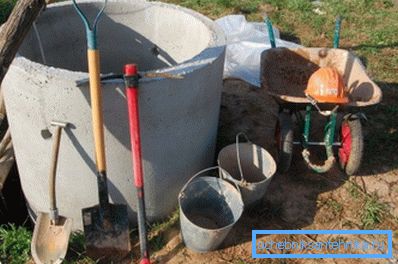
How is this work done?
- Under the ring lying on the ground a small dig is made.
- Next to it, a small log, brick or any other durable object fits as a stop for the lever.
- The ring is lifted by a lever of sufficient length - a log, a bar or a pipe. A couple of rounded logs roll up under the raised edge, which will perform the function of rollers when moving a concrete product.
- The operation is repeated on the other side of the ring. The total number of rollers that should be under the ring must be at least four.
- The ring is transported to the place of permanent deployment. Rollers are enclosed under it as you move. To put the ring on the ground, use is already familiar to us maneuver with the lever and focus for him.
- The pit breaks away inside the ring and under its walls. As excavation occurs, it gradually settles.
- When its top edge is equal to the ground level, the next ring is transported and installed from above in the manner described above - and so on until victory.

Tip: the mirror of water should be at least one and a half meters above the bottom. Thus, we are backed up by a seasonal drop in the water level. In addition, a pump suspended at some distance from the bottom will suck up less sludge and other suspended matter.
Bottom filter
How to make a well in the country, if the requirements for cleanliness of water are high enough?
It is equipped with a so-called bottom filter, which will limit the entry of suspended matter into the water.
- The bottom is leveled and cleaned of dirt. Of course, this will have to dig a shallow pit and pump out all the water.
- Then the well for 20-30 centimeters is filled with coarse sand. Actually, its layer will provide effective filtration.
- The next layer is small crushed stone (approximately 20 centimeters).
- Finally, the surface of the bottom filter is formed from small boulders. They will not only prevent you from accidentally scooping out the filtering sand, but also reduce the silting of the bottom: sludge will settle on the stones.
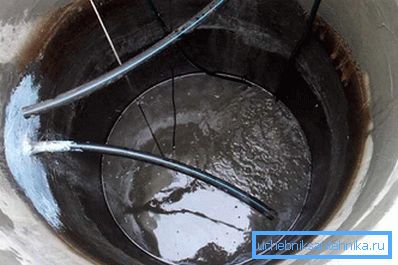
When the filter is put into operation, the well is completely pumped out two or three times. Thus, we will wash not only the sand of the filter, but also the aquifer: the high speed of the movement of water in it will remove part of the accumulated suspended matter.
Pump and tying
What are the signs of choosing a pump for a well? Will you need to buy some additional equipment?
It all depends on your goals.
Watering
If the sole purpose of the construction of the well is watering the beds, it is quite possible to do with a submersible drainage pump. The price of devices with a capacity of about 120 liters per minute is 2.5 - 3 thousand rubles. The pump is able to lift water with a significant amount of suspended matter and creates a pressure of 10–20 meters at the outlet, which is quite enough for a small area.
Please note: the presence of a float switch is a definite plus. Switching off at low water level will prevent the pump from overheating: the electric motor is cooled by the pumped liquid.
In this case, of the additional equipment, only a reinforced watering hose and a clamp with which this hose will be crimped at the pump nozzle is required.
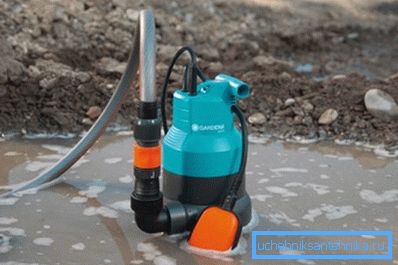
Permanent water supply
But in the case of constant water supply, the requirements for the pump and its binding are completely different.
- The pump must be designed for continuous operation without repair and, if possible, without maintenance.
- The water system requires a large excess pressure. It is necessary for the normal operation of the faucets and valves of the toilet cisterns: rare fittings can operate at a pressure of one to two meters.
- Rigging of the pump should provide him with the possibility of periodic stops without pressure loss in the water supply.
How are the tasks we set?
The optimal choice of pump depends on the amount of impurities in the water. If there are few of them (no more than 30 grams per cubic meter), you can give preference to relatively inexpensive vortex devices. Their characteristic feature is the minimum clearance between the impeller and the casing, due to which, with compact dimensions, quite decent head and performance are ensured.
For water with a lot of suspensions, centrifugal pumps are much better suited. The increased clearance is compensated by the presence of several stages, each of which consists of an impeller and a diffuser. The more steps, the higher the pressure at the outlet.
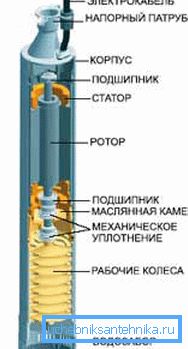
Useful: with a well depth of not more than 7 meters, you should pay attention to surface pumps. If the distance from the surface to the mirror of water is more - alas, such a product simply will not lift the water column.
What pressure and performance should be oriented?
The pressure should be about 30 meters higher than the depth of the well. Often, another 10 percent is added to the obtained result for unreported losses.
When evaluating the required performance, it is worth starting from 50 liters per minute for a family of three. As the number of consumers increases, the need for water increases proportionately.
What's wrong with the strapping?
It should include:
- Check valve It is installed after the outlet of the pump and does not allow water to drain back when the motor is stopped.
- Coarse filter and a couple of valves that shut it off. The sand in the water supply system from the well is the guarantee of the short and unhappy life of any mixer with a ceramic cartridge or faucet.
- Accumulator or storage tank. The first device is mounted at any point in the water supply system and maintains a constant pressure in it, when it drops, the sensor gives the command to turn on the pump power to a special relay. Capacity is also equipped with a float level sensor; pressure in the water supply system is provided by the location of the tank at the top of the building.
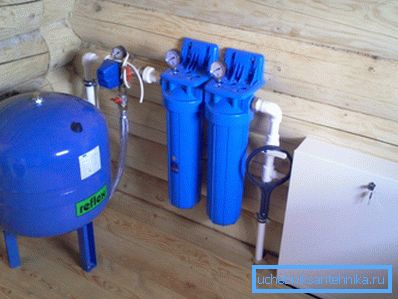
Garbage protection and clearance
How to refine the well in the country and protect it from debris?
The simplest protection that is easy to make with your own hands is a regular cap. It is a shield knocked out of the boards, soaked with antiseptic to protect against rotting. If you have the opportunity to choose the type of wood for the cover, it is better to stay on the extremely resistant to rotting larch.

An advanced version that will require a lot of time and material - a kind of house that can protect the well not only from dust and rubbish, but also from freezing in winter. The material for it is usually timber and planks; To waterproof the surface, traditional roofing materials are used - from roofing felt to metal tile.
What and how to paint a well in the country?
- It is best to just saturate wooden elements with linseed oil. As an option - they can be covered with polyurethane yacht varnish, very resistant to moisture and mechanical wear.

- How to paint a well in the country, if above the ground level there are only concrete and steel elements of its structure? Concrete is primed with any penetrating primer, after which the entire structure is painted with PF-115 enamel or its imported alkyd-based counterparts.
Conclusion
If some moments were left incomprehensible to the reader, the video in this article may clarify. Successes!